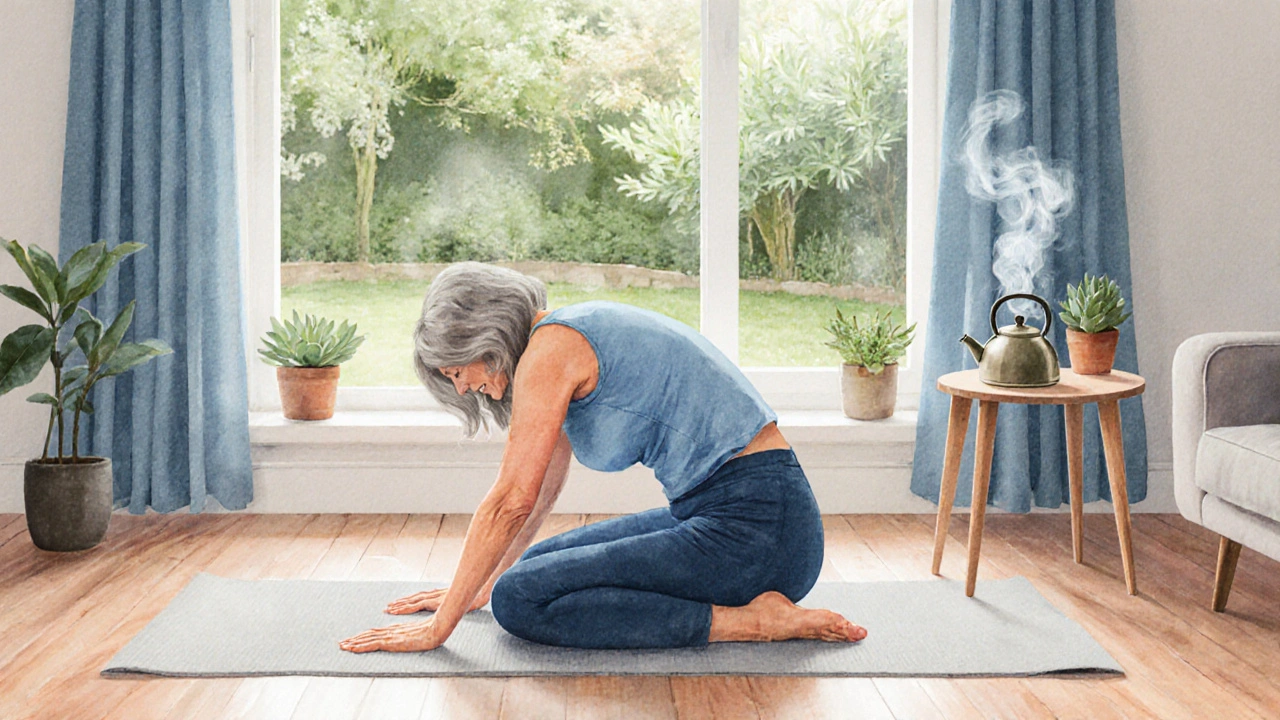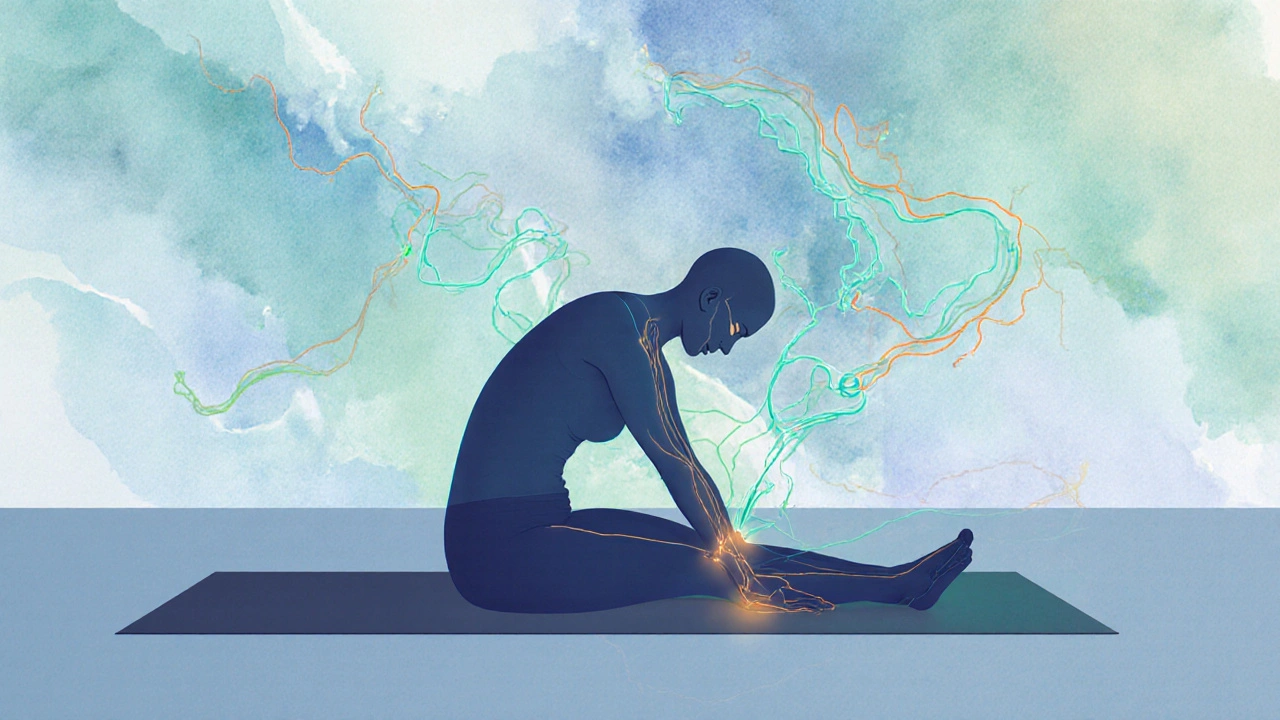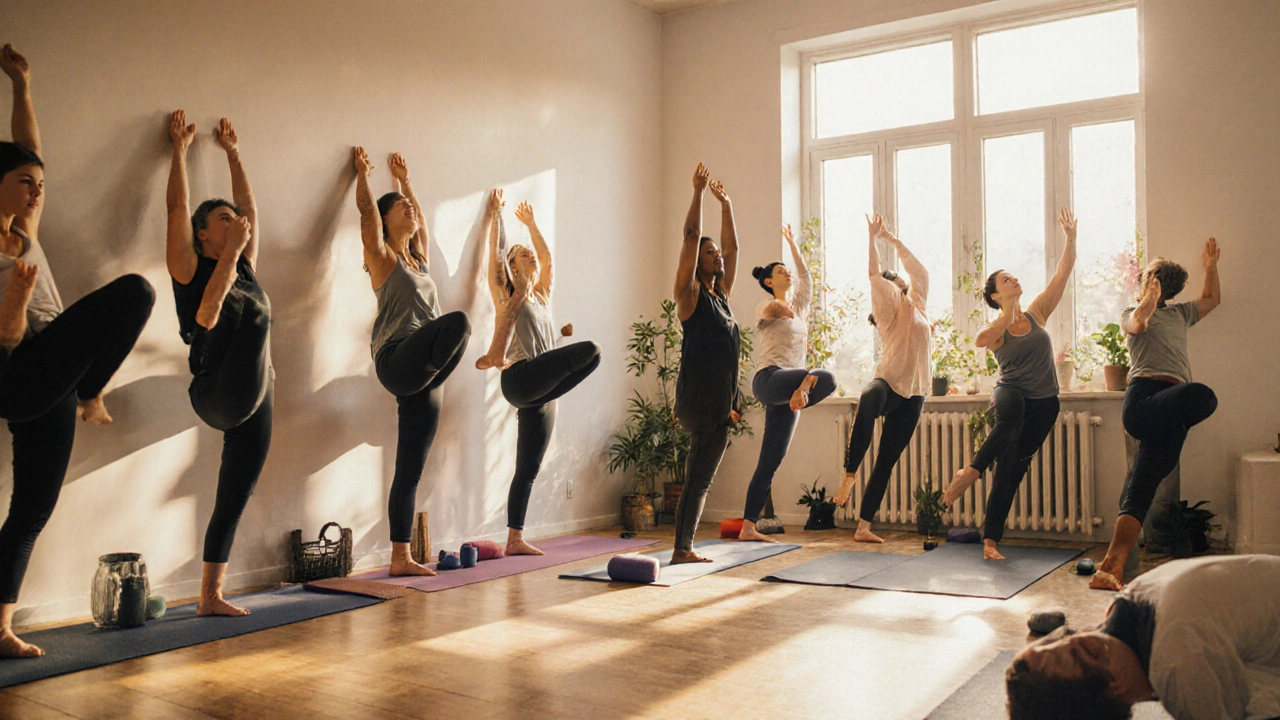Oedema Management Yoga Routine Planner
This tool helps determine the ideal yoga routine duration and frequency to manage oedema symptoms based on your current activity level and goals.
TL;DR
- Yoga improves lymphatic flow and circulation, helping the body move excess fluid out of swollen tissues.
- Specific poses-legs up the wall, gentle twists, and supported inversions-target the lower limbs where oedema most often appears.
- Pranayama (breathing) reduces stress‑related hormonal spikes that can worsen fluid retention.
- A short, 20‑minute routine three times a week can complement compression stockings or medication.
- Start slowly, listen to your body, and consult a healthcare professional if you have heart or kidney issues.
When it comes to gentle, low‑impact movement, Yoga is a mind‑body practice that combines postures, breathing and meditation to promote physical and mental balance. Yoga for Oedema isn’t a magic cure, but it taps into the body’s own waste‑removal systems-especially the lymphatic network-to keep fluid from pooling in the feet, ankles and legs.
Oedema (also spelled edema) is the abnormal accumulation of fluid in the interstitial spaces of the body, often visible as swelling in the lower extremities. Common triggers include chronic heart failure, kidney disease, venous insufficiency, pregnancy and prolonged standing. While doctors may prescribe diuretics or compression garments, lifestyle tweaks like yoga can address the root cause: sluggish fluid transport.
Why Yoga Affects Fluid Balance
The lymphatic system is a one‑way network of vessels and nodes that clears waste, proteins and excess fluid from tissues. Unlike the circulatory system, it has no pump; it relies on muscle contractions, joint movement and deep breathing to push lymph forward. Yoga delivers all three:
- Dynamic postures compress and release muscles, creating a gentle “milking” effect that nudges lymph through its channels.
- Inversions (even mild ones) use gravity to encourage fluid return from the legs to the torso.
- Pranayama (breathing exercises) expands the thoracic cavity, increasing venous return and lymphatic flow.
Research from the International Journal of Yoga (2022) showed participants with chronic venous oedema who practiced a 30‑minute yoga routine three times a week reduced leg circumference by an average of 1.2cm after eight weeks, comparable to compression therapy.
Core Yoga Practices for Oedema
The following poses are gentle enough for beginners yet specifically target the lower body’s fluid pathways. Hold each pose for 30‑60 seconds, breathing steadily. Use props-blocks, bolsters or folded blankets-to keep the experience comfortable.
- Viparita Karani (Legs‑up‑the‑Wall): Lie on your back, sit close to a wall and swing your legs upward. This mild inversion eases venous pressure and encourages lymph to flow back toward the heart.
- Supta Baddha Konasana (Reclined Bound‑Angle): With the soles of the feet together and knees open, place a bolster under each thigh. The gentle stretch opens the groin and pelvic lymph nodes.
- Supported Bridge Pose: Use a block under the sacrum. The lift activates the glutes and hamstrings, muscles that act as lymphatic pumps for the thighs.
- Gentle Seated Twists: Sit cross‑legged, inhale, then exhale while turning the torso to each side. Twisting compresses abdominal organs, stimulating the mesenteric lymph flow.
- Marjaryasana‑Bitilasana (Cat‑Cow Flow): A rhythmic spinal flexion-extension that creates a wave‑like motion throughout the torso, aiding overall circulation.
For those with limited mobility, practicing the same motions while seated on a sturdy chair still triggers the needed muscle contractions.

Breathing & Pranayama Techniques
Breathwork is the quiet hero of oedema control. Two simple patterns are especially effective:
- Dirga Pranayama (Three‑Part Breath): Inhale deeply into the abdomen, rib cage, then clavicles; exhale slowly, reversing the order. This expands the thoracic cavity, boosting venous return.
- Nadi Shodhana (Alternate Nostril): Balances the autonomic nervous system, lowering cortisol levels that can cause fluid retention.
Spend five minutes on these breathing cycles at the beginning or end of your yoga session. Consistency helps keep the sympathetic nervous system in check, reducing stress‑induced swelling.
Designing a Safe Yoga Routine
Start with a modest goal: 10‑15 minutes, three times a week. Gradually increase duration as comfort improves. Keep these safety pointers in mind:
- Medical clearance: If you have heart failure, severe kidney disease, or uncontrolled hypertension, talk to your doctor before beginning.
- Listen to pain signals: Mild discomfort is okay; sharp pain means you’re overdoing it.
- Stay hydrated: Adequate water helps the lymphatic system move fluid more efficiently.
- Use props: A bolster, pillow or sturdy wall can turn a challenging pose into a restorative one.
Sample 20‑minute routine:
- 2min: Diaphragmatic breathing (Dirga Pranayama)
- 3min: Viparita Karani
- 4min: Gentle cat‑cow flow + seated twists (30sec each side)
- 3min: Supported Bridge
- 3min: Supta Baddha Konasana
- 2min: Nadi Shodhana
- 3min: Savasana (rest) with a light stretch of legs
Consistency beats intensity. Even a short, daily practice can keep fluid from building up.
Yoga vs. Traditional Oedema Treatments
| Aspect | Yoga | Compression Therapy | Diuretics (Medication) |
|---|---|---|---|
| Mechanism | Muscle‑driven lymphatic pumping and stress reduction | External pressure forces fluid back toward the heart | Pharmacologic removal of excess sodium and water |
| Side Effects | Minimal; possible muscle soreness | Skin irritation, discomfort if applied too tightly | Electrolyte imbalance, kidney strain |
| Cost | Low (mat and props) | Moderate (custom stockings) | Variable (prescription) |
| Long‑term Sustainability | High - becomes a lifestyle habit | Medium - requires daily wear | Low - depends on ongoing prescription |
| Additional Health Benefits | Improved flexibility, mental calm, better sleep | Limited to edema control | None beyond fluid reduction |
Yoga doesn’t replace medical therapy when it’s necessary, but it can lower the dose of diuretics, reduce reliance on compression garments, and enhance overall quality of life.
Common Pitfalls and How to Avoid Them
- Skipping the inversion: Without at least a mild inversion, the gravitational benefit is lost. Even a 5‑minute legs‑up‑the‑wall session counts.
- Holding breath: Breath retention spikes intra‑abdominal pressure, which can trap fluid. Focus on steady, even breathing.
- Too‑intense flow: Vigorous vinyasa sequences may cause inflammation. Stick to restorative or Hatha styles for oedema.
- Ignoring medical advice: Yoga complements, not replaces, prescribed treatment. Keep your healthcare team in the loop.

Frequently Asked Questions
Can yoga cure oedema completely?
Yoga is a powerful tool for managing fluid buildup, but it rarely cures the underlying medical cause on its own. It works best as a complementary habit alongside doctor‑recommended treatments.
How long before I see results?
Most people notice reduced swelling after two to four weeks of consistent practice (20‑30minutes, three times a week). Individual results depend on the severity of the oedema and any concurrent medical therapy.
Are there poses I should avoid?
If you have severe heart failure, avoid deep inversions like headstand or shoulder stand. Stick to supported versions (legs up the wall, gentle bridges). Always check with your cardiologist before attempting any pose that places the head below the heart.
Do I need a yoga mat?
A non‑slip mat provides comfort and stability, especially for seated twists and supine poses. If you’re on a carpeted floor, a folded towel can work as a makeshift mat.
Can yoga help with lymphedema after breast cancer surgery?
Yes. Gentle shoulder rolls, arm raises, and breathing exercises improve lymph drainage in the upper body. Many cancer‑rehab centers now incorporate yoga into lymphedema protocols, reporting reduced arm swelling and improved range of motion.



When we speak of health we must recognise the moral duty to pursue practices that honour our bodies. Yoga, though gentle, becomes an ethical act when it supports fluid balance and reduces reliance on medication. Yet many treat it as a fad, overlooking the deeper responsibility to integrate it mindfully. The discipline demands consistency, not occasional vanity.
Honestly, I kinda feel this whole yoga‑for‑edema thing is overblown, but I gave it a try because the article made it sound easy. I started with the legs‑up‑the‑wall pose and didn't notice any instant miracle, yet after a few weeks my ankles felt a tad less puffy. The breathing exercises were simple enough, just deep sighs, and didn't require any fancy equipment. I also liked that the routine didn't ask me to sprint or lift heavy stuff, which fits my lazy vibe. The only downside was remembering to do it three times a week; my procrastination kicked in often. Still, I think it's a decent supplement to my meds, not a replacement. If you have a busy schedule, even a short 10‑minute session can be okay. Bottom line: it’s not a cure, but it’s a low‑effort habit that might help.
While the piece extols the lymphatic pumping benefits of yoga, it conveniently ignores the complex hemodynamic variables that modulate interstitial fluid shift. From a pathophysiological standpoint, the mere act of mild inversion may not generate sufficient transmural pressure gradients in chronic venous insufficiency. Moreover, the suggested 20‑minute duration is arbitrary, lacking stratification by capillary filtration coefficient (Kf). A more nuanced protocol would integrate intermittent pneumatic compression alongside targeted asanas. Nonetheless, the low‑impact nature of supported postures does present a minimal risk profile for most patients.
The body, in its quiet architecture, mirrors the metaphysical notion that movement begets equilibrium. When we gently coax the limbs through deliberate postures, we are not merely exercising muscles but engaging the subtle currents that sustain life. The lymphatic flow, often unseen, becomes a river once stirred by rhythmic breath and joint articulation. In this sense, yoga serves as a bridge between the tangible and the ineffable, guiding fluid from the periphery toward the heart’s center. Each breath acts as a mantra, amplifying the intent of motion. By honoring this practice, we align with a deeper principle of self‑regulation. Thus, the routine described becomes a poetic act of self‑care.
Yo, folks, let’s cut to the chase-adding a gentle inversion like legs‑up‑the‑wall can literally flip the script on stubborn swelling. Think of your legs as a traffic jam and yoga as the traffic cop, redirecting the flow back toward the main road. Pair that with deep belly breathing, and you’ve got a one‑two combo that calms the nervous system while clearing excess fluid. The best part? You don’t need fancy gear, just a mat, a wall, and maybe a pillow for comfort. Keep the sessions short, consistent, and you’ll likely notice your shoes fitting a bit looser over time. Remember, it’s about balance, not burnout-listen to your body and adjust. Stay chill, stay moving.
Hey there! If you’re just starting out, try the supported bridge with a block under your sacrum-it’s gentle on the back yet activates the glutes, which act like a pump for the thighs. Pair that with a few minutes of Dirga Pranayama, and you’ll feel a soothing expansion across the chest. Consistency is key, so aim for 10‑15 minutes three times a week and watch the swelling ease. And don’t forget to stay hydrated; water helps the lymph move more efficiently.
Adding yoga to your edema routine can complement medical treatments by encouraging lymphatic circulation 😊. Start with the legs‑up‑the‑wall pose for 5 minutes, then transition to gentle cat‑cow flows to mobilize the spine 🐱🐮. Finish with Nadi Shodhana to calm the nervous system 🧘♂️. Keep the practice regular and you’ll likely notice reduced puffiness over a few weeks. Remember to check with your healthcare provider before beginning.
The routine looks solid; a short 10‑minute session works for beginners.
One cannot discuss the corporeal management of edema without first confronting the epistemological underpinnings of bodily autonomy; indeed, the very act of engaging in yoga presupposes a willingness to negotiate with one’s own physiological constraints. The lymphatic architecture, though invisible, operates on principles analogous to the subtle currents that govern the cosmos-its flow is contingent upon rhythmic muscular contractions, much like the tides respond to lunar gravitation. By incorporating inversions, one inverts not only the physical orientation but also the hierarchical perception of self over fluid accumulation. The deliberate, measured inhalation of Dirga Pranayama serves as a catalyst, expanding the thoracic cavity and fostering venous return in a manner reminiscent of atmospheric pressure differentials. Moreover, the practice of Nadi Shodhana introduces a psychophysiological equilibrium, attenuating cortisol spikes that otherwise exacerbate capillary permeability. It is, therefore, not a mere exercise regimen but a holistic protocol that aligns somatic function with subtle energetic fields. When executed consistently-three sessions of twenty minutes per week-the accumulated effect approximates the therapeutic efficacy of compression therapy, while also bestowing ancillary benefits such as enhanced proprioception and mental clarity. The modest investment of time also circumvents the iatrogenic risks associated with diuretic overuse, notably electrolyte disturbances and renal stress. Critics who dismiss yoga as “fluff” neglect the burgeoning corpus of peer‑reviewed literature elucidating its impact on lymphatic dynamics; indeed, the International Journal of Yoga (2022) provides empirical affirmation. It is imperative, however, to tailor the practice to individual capacity, acknowledging that severe cardiac insufficiency warrants medical clearance prior to deep inversions. The inclusion of props-bolsters, blankets, blocks-mitigates the risk of overextension, ensuring that the practitioner remains within safe biomechanical limits. In sum, yoga operates as a low‑cost, low‑risk adjunct that synergizes with conventional modalities, offering a multidimensional approach to edema management. Practitioners often report improved sleep quality, which further supports fluid homeostasis. The meditative component also cultivates mindfulness, reducing stress‑related sympathetic tone that can aggravate swelling. Thus, the integration of yoga into daily routine represents a prudent, evidence‑based strategy for holistic health. 🌿🧘♀️💧
From a cultural perspective, yoga embodies a centuries‑old tradition of honoring the body's internal rhythms, making it a perfect ally against edema. The practice resonates across continents, reminding us that fluid balance is a universal concern. By adopting these poses, we partake in a shared human heritage of movement and breath. The dramatic rise of leg‑up‑the‑wall across social media illustrates its accessibility and appeal. Embracing this heritage can inspire compassionate self‑care.
It’s truly inspiring to see how a simple, consistent yoga habit can transform the way our bodies handle fluid, especially for those battling chronic swelling. Every gentle stretch becomes a celebration of progress, a tiny victory that compounds over weeks into noticeable relief. Imagine slipping into shoes that once felt tight and feeling that subtle liberation-it's a reminder that small, mindful actions wield powerful change. The routine’s modest time commitment respects busy lives while still offering profound benefits. As you persist, you’ll likely notice not just reduced edema, but also improved mood, better sleep, and a brighter outlook. Keep nurturing this practice; the body’s gratitude will reveal itself in many delightful ways.
Behold, the humble inversion-a spectacular act where gravity itself bows to the will of the practitioner! In the grand theatre of the body, legs‑up‑the‑wall takes center stage, lifting the veil of swelling with regal poise. Each inhale is a drumbeat, each exhale a sigh of surrender to the currents of the lymph. The drama unfolds as fluid retreats, guided by the choreography of breath and pose. This is not mere movement; it is an epic saga of reclamation, a triumphant crescendo of health. Let the curtain rise on your own personal odyssey toward lighter limbs.
Nice tips 😊.
The suggested 20‑minute flow aligns well with typical daily schedules, making it feasible for most individuals. Incorporating props such as a bolster or block ensures safety while maximizing the therapeutic effect. Moreover, the routine respects cultural diversity, as many of these poses have roots in various traditions worldwide. Consistency and proper hydration will further enhance lymphatic drainage.
Skipping the inversion entirely defeats the purpose of promoting fluid return; even a mild legs‑up‑the‑wall is essential. The routine’s emphasis on breathing shouldn’t be overlooked-steady diaphragmatic breaths drive the thoracic pump. Stick to the plan, and you’ll likely see measurable improvement.
Got the routine set up and feeling the difference already; the legs‑up‑the‑wall really helps after long days at the desk :) Keep it consistent and stay hydrated.
The article mentions a 15‑minute minimum-does the benefit plateau after a certain duration? I’m curious if the same protocol applies to lower‑body lymphedema post‑surgery. Any thoughts on adapting the poses for limited mobility would be appreciated.
Whilst the author extols the virtues of yoga as a panacea for oedematous conditions, one must not disregard the latent perils inherent in the uncritical adoption of such practices. The cavalier promotion of inversion poses, absent rigorous cardiological endorsement, may inadvertently precipitate deleterious hemodynamic shifts in susceptible individuals. Moreover, the purported equivalence to compression therapy rests upon a nebulous foundation of anecdotal reportage rather than incontrovertible randomized control trials. It is, therefore, incumbent upon the discerning reader to scrutinise the underlying data, lest one be ensnared by the seductive allure of wellness fads. In a climate rife with concealed agendas, one must remain vigilant against the covert commodification of health under the guise of holistic harmony.
While your caution is noted, dismissing yoga outright borders on the dogmatic; many patients have safely benefited under medical supervision. It is not a reckless fad but a structured adjunct, and blanket condemnation disregards individual autonomy. Encourage informed choice rather than alarmist bans.